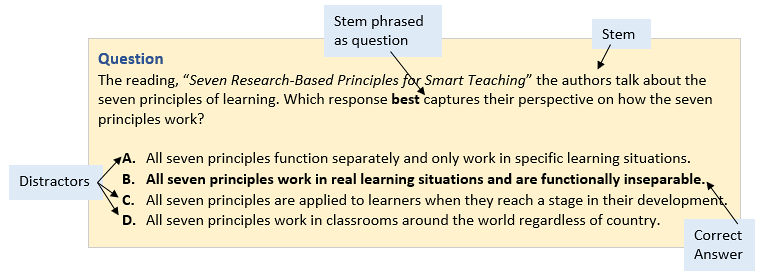Writing Proper Multiple-Choice Questions
20 Tips for Creating Multiple-Choice Questions
This page lists the essential tips for writing effective multiple-choice questions.

| Each question should only be designed to assess one single objective/purpose. Do not aim to assess more than one concept or content item per question. | Each question should include one and only one correct or clearly best answer. One alternative is the correct answer. | Put each choice on a different line with a letter choice. Don’t put all on one line. | Place the student tasks in the item stem (stem is the question/problem). The item stem should clearly state the question to be answered e.g., select the best response, select the most accurate response, select the most appropriate answer etc. Students need to know their actions without having to read the response options. |
| Put repeated terms in the item stem. (e.g., articles, words that start each answer) | The stem may be in the form of either a question (best) or an incomplete statement (okay) – but should be worded positively if possible. For example: The capital of British Columbia is and then a listing of 4 choices…should be better words at “Which of the following cities is the capital of British Columbia?” and then the listing of choices. | Construct four suggested solutions (alternatives). Research indicates 4 is a good number. Ensure each alternative is worded clearly and concisely. Irrelevant material should be avoided. | Three alternatives are incorrect or inferior alternatives (distractors). The purpose of the distractors is to appear as plausible solutions for those students who have not achieved the objective being measured by the test item. Do not use absurd or unbelievable distractors because that just gives away the answer or makes it far easier to guess from fewer plausible choices. Try to make all the distractors as homogenous as possible so only the student who has fully understood the question can easily select the correct answer. |
| Make sure all responses are relatively equal in length. Avoid making the correct response either the longest or the shortest in length. Often the correct responses are the longest. | Put options in a logical order, if possible. (e.g., alphabetical, chronological so no bias and so students don’t try to guess because or the order they are listed) | Make sure all the grammar, punctuation and spelling are correct. Use simple, precise, and unambiguous wording. Students will be more likely to select the correct answer by finding the grammatically correct option. | Avoid grammatical clues to the answer. (e.g., an, a – which indicate a vowel/non-vowel word).Ensure items are not interdependent meaning the information in one question should not supply the answer to another or the next question. |
| Do not include unneeded words. Keep simple. | If “no” or “not” is used, bold the word. Try to avoid using negative constructions in the stem. Students may not be able to find an incorrect answer without knowing the correct answer. | Try to avoid use of “all of the above” – use reduces effectiveness of question and test score reliability. Students merely need to recognize two correct options to get the answer correct. | Try to avoid the use of “none of the above” as you’ll never know if students know the correct answer. |
| Avoid using (a) no-exception words such as never, all, none and always (they signal an incorrect response) and (b) qualifying words such as often, seldom, sometimes (signal correct responses). | Place the correct answer in each possible position equally often or align with an answer key. | Use capital letters (A. B. C. D.) rather than lower case letters (e.g., “a” gets confused with “d” and “c” with “a” if the photocopying isn’t clear) | Emphasize higher level thinking where you can by asking students to analyze, compare, contrast etc. Higher level questions do not necessarily take more time to develop. Students will appreciate questions that make them think than just simply recall on memory. |
More Help? Writing Good Multiple Choice Questions by Cynthia J. Brame — https://cft.vanderbilt.edu/guides-sub-pages/writing-good-multiple-choice-test-questions/